Grevillea banksii



Woody
Stems and branches with a woody texture commonly associated with shrubs or perennials.
Small dome / Mallee
A shrub to small tree with a rounded crown and with or without multiple trunks.This variable shrub to small tree has grey brown bark and forms open rounded bushy habit. It has slender lobed grey green leaves that are silvery underneath and the small red tube-shaped flowers appear in a cylindrical raceme from winter to spring.
Grevillea banksii R.Br. is naturally found in fragmented locations along the coast in eastern Queensland from Townsville to Brisbane and the adjoining islands, in Australia. It grows on ridges and in open woodlands in exposed positions, appearing from sea level to an elevation of 250 m (820 ft). It prefers a well drained, moist-dry sandy to gravelly clay soil that is acidic to neutral with a pH range from 5.5 to 7.0. It grows in an open to exposed sunny position and is drought, salt spray and humidity tolerant but frost tender with a preferred minimum winter temperature of 5ºC (41ºF).
Bank's Grevillea and its cultivars are grown for their colourful flowers and variable growth habit. It is planted in parks or gardens as a specimen or in shrub borders for screening and to attract birds. It is also used in coastal gardens tolerating exposed positions or can be cultivated in tubs and planter boxes. It has a vigorous growth rate establishing in 2 to 3 years and matures in 10 years. There are many cultivars available with varying flower colour and growth habit. Once established it has a medium water requirement, (Scale: 2-drops from 3) and responds to mulching preferring ample moisture during summer.
I.D. 156
UK hardiness zone H2
Climate zones 16 - 24, H1
USDA Zone 9-11
Grevillea (gre-VIL-ee-a) banksii (BANK-see-eye)
Etymology
Genus: Grevillea– named after Charles Francis Greville (1749-1809) co-founder of the Royal horticultural Society
Species: - banksii – from ‘banks’ in honour to the British botanist Sir Joseph Banks (1743-1820).
Variations
Tree Form
This small tree grows to 10 m (30 ft) tall with spreading branches that forms an open habit and is commonly seen in forests of south east Queensland near Bundaberg. It produces lobed leaves and the flowers are cream to pink and red. It commonly acts as a wound plant intermittently filling damaged areas of forest.
var. forsteri
This shrub is upright and bushy to 3 m (10 ft) and produces silvery leaves and red or white flowers in spring.

White form
Townsville Form
This small tree grows to 10 m (30 ft) tall with spreading branches that forms an open habit, but unlike the 'Tree Form' this tree has smaller flowers and inflorescence, up to 60 mm (2 3/8 in) long.
Prostrate Coastal Form 'Prostrate'
This Queensland shrub has an upright trunk to 150 mm (6 in) tall with downward spreading branches that form a mound to prostrate habit. The leaves are silvery-grey and the flowers are cream, white or red and the plant is found in exposed coastal positions growing on poor sandy soils.

Cultivars
'Alba'
This small shrub to 2 m (6 ft) has a bushy habit and produces white flower heads throughout the year. It prefers a full sun protected position and grows on well drained moderately fertile moist soil. It has a medium water requirement once established.
'Autumn Waterfall'
This shrub is a hybrid between Grevillea bipinnatifida x Grevillea 'Honey Gem' and grows to a high of 1m (3 ft) tall by 1.5 m (5 ft) wide forming a shrubby habit. It has dark green deeply lobed fern-like foliage and produces racemes of orange-yellow flowers from winter to spring. It is planted long garden borders to attract birds or used as a groundcover on embankments. It grows in most well drained moderately fertile sandy soils in an open sunny positions.

'Flamingo'
This plant grows to a height and width of 3 m (10 ft) with arching stems that can contain up to twelve pink blooms. The flowers appear throughout the year and the plant tolerating light frost and moderately well drained soils. It has a medium water requirement once established.

'Honey Gem'
This upright shrub to small tree has honey-yellow flowers that appear profusely during spring and is an excellent specimen plant.

'Kingaroy Slippers'
This plant has purple-red flowers and the perianth tube looks like a slipper. It is very simular to the species and may not be regarded as a true cultivar. It has a medium water requirement once established.
'Mason's Hybrid' syn. Ned Kelly
This fast growing spreading shrub to 2 m (6 ft) tall is a cross between G. banksii and G. pinnatifida and produces dark green, deeply divided leaves. The showy orange-red flowers appear throughout the year and are highly bird attractive. It prefers an open full sun position tolerating light frost and grows on well drained moderately fertile moist soils. It is used in border planting and tolerates a light regular prune. It has a medium water requirement once established.

'Misty Pink'
This vigorous shrub grows to 5 m (15 ft) tall by 4 m (12 ft) wide with greyish lobed leaves and light pink flowers that have contrasting ivory white styles. The flowers are produced throughout the year and are bird attracting. It is planted in shrub borders or as a specimen in small gardens. It is primarily a subtropical plant but tolerates cooler climates in a semi-shaded to full sun position on well drained moist soils. It has a medium water requirement once established.
'Moonlight'
Grevillea Banksii x Grevillea whiteana
This erect shrub grows to 4 m (12 ft) tall by 3 m (10 ft) wide forming a bushy habit with deeply pinnatisect dark green leaves with 9 to 11 narrow lobes. The attractive terminal raceme is up to 120 mm (4 ¾ in) long and the flowers are creamy white to bluish pink appearing throughout the year and are bird attracting. It is planted in shrub borders or as a specimen in small gardens and is moderately long lived. It prefers a moist well drained moderately fertile soil in semi-shaded to full sun position and is suitable for coastal regions and is drought and frost tender. It is moderately drought, salt and lime tolerant and has a medium water requirement once established.
'Paddy’s Pink'
This hybrid Grevillea is derived from ‘Misty Pink’ and grows to 2.5m (7½ ft) tall and wide forming a compact bushy habit with greyish lobed leaves. From spring to summer it produces masses of flower heads with soft rose pink flowers with yellow tipped styles. It grows in a open sunny to semi shaded warm position and is light frost tolerant. It prefers a well drained moist sandy to clay loamy soil and is planted along borders for screening or as a specimen in small gardens attracting birds and bees. The flowers can be cut for floral arrangements and the plant can be grown in tubs or planter boxes.
'Peaches and Cream'
This frost tolerant bushy shrub with bright green leaves and produces a peach-coloured flower. It is drought tolerant and requires little care once established. Suitable for small gardens, pots and courtyards. It has a medium water requirement once established.

'Ruby Red'
This prostrate plant produces silvery lobed leaves and bright red inflorescences up to 60 mm (2 3/8 in) long. It is an excellent ground cover but dislikes cold conditions and is drought tender. It has a medium water requirement once established.

'Sandra Gordon'
This shrub to small tree grows to 6 m (20 ft) tall by 3.5 m (11 ft) wide with a trunk with grey furrowed bark and spreading branches that form an irregular rounded crown. The leaves are deeply divided and the bright yellow nectar rich flowers are arranged in a narrow raceme that appears from late winter to spring. It prefers a wind protected sunny position and grows on well drained moist soils and has a medium water requirement once established.
'Superb'
This shrub grows to 2 m (6 ft) tall by 2 m (6 ft) wide and has a low spreading habit. The leaves are deeply divided and the large slightly pendant flower heads are reddish-orange appearing throughout the year. It is planted in borders for screening or as an informal hedge tolerating a light prune and is bird attracting. It prefers an open sunny position in moist well drained soil and tolerates a light frost but is drought tender. It has a medium water requirement once established.
'Sylvia'
This small to medium size shrub grows to 4 m (12 ft) tall by 3 m (10 ft) wide with woody stems that form a bushy habit. The greyish leaves are divided, fern-like and are bronze-coloured when young. The reddish-pink flowers are arranged in large cylindrical flower head appearing throughout the year and are bird attracting. It is used in border planting for screening and the flowers may be used in floristry. It must have well drained moderately fertile moist soils and prefers a full sun to semi-shaded position and is drought tender but light frost tolerant. It has a medium water requirement once established.

'Yamba Sunshine'
This shrub to small tree grows to 3.5m (12 ft) tall by 2.5m (8 ft) wide. It has a grey furrowed trunk and slender spreading branches that form a dense bushy habit. The bright green leaves are deeply divided and the soft yellow nectar rich flowers are arranged in a narrow raceme that appears from autumn to spring or sporadically throughout the year. It prefers a wind protected sunny position and grows in well drained, moist sand to loamy soil and has a medium water requirement once established. The flowers attract birds and bees and the plant is used for screening or as a specimen.
Note:
There are three prostrate forms they all grow to 1 m high with a spreading habit that produce white or red flowers. One form has small leaves to 70 mm (2 2/3 in) long.

Australia (Eastern Queensland)
Grevillea Species
A majority of this genus is endemic to Australia with a larger proportion found in south-western Western Australia.
They consist of prostrate shrubs, shrubs and trees with a large range of foliage types and are usually bird attracting.
The inflorescences range from globular heads that may be elongated to toothbrush-like one sided raceme.
The individual flowers consist of a perianth tube that is made up of four segments that are fused except for one side. There are four stamens that are arranged at the tip of the perianth tube and a long hooked style.
Pollination mechanism
Ripe pollen is shed onto the unripe stigma where visitors pick it up. When the pollen is removed or it dries up the stigma becomes ripe and sticky ready for another visitor to deposit pollen, which will grow and induce fertilisation.
The fruit is a capsule (follicle) and is normally leathery splitting to release one or two winged seeds.
Propagation
Although the seeds are viable seedling stock can vary from the parent plant. Grevilleas are normally grown from semi-hardwood cuttings that produce sensitive roots. Care should be taken when potting up or planting out.
Plants derived from cuttings are busher than seedling stock.
Soils
Grevilleas will tolerate most soil types though they tend to prefer slightly acidic sandy or clay soil types that are well drained.
Aspect
Grevilleas will grow in full sun to shade positions though flower production will diminish in shade. They can tolerate dry periods and some tolerate frost, most of the genus is hardy and tolerate neglect.
Proteaceae (pro-tee-AY-see-ee)
Protea Family
Distribution
This family of dioecious or monoecious trees and shrubs that mainly appear in the southern hemisphere with some found in Central America and Africa. They are abundant in the southern part of Australia and normally grow on poor infertile soils that are tending acidic. Their habitats include shrubland, grassland, rainforests, alpine meadows and tropical lowlands
Diagnostic Features
The highly variable leaves are arranged alternate, opposite or whorled and are compound, dissected or lobed or pinnately toothed or simple. The margin is entire or pinnatisect and without stipules. The leaf shape can vary at different stages of growth, juvenile to adult.
The normally bisexual flowers are regular or irregular arranged in racemes or compound inflorescences (cone-like); some are solitary and appear in the leaf axils.
There are normally 4 perianth-segments that are free or united and are arranged in a single whorl, petaloid and valvate in bud joined when young and separating as the tube splits down one side.
The 4 stamens are all fertile and appear opposite the perianth segments and may be reduced to staminodes.
The filaments are partly or wholly attached to the tepals often sessile and the anthers are four chambered opening with longitudinal slits.
The ovary is superior and has one carpel that contains one chamber with one to many ovules.
The hooked style is simple and the stigma is small bulbous (capitate) or maybe bilobed.
The fruit are dehiscent or indehiscent follicle or drupe or achene with few or many winged seeds.
Note:
Some species are used for food, alcoholic drink, herbal remedies and extensively used in ornamental and domestic gardens for their fantastic flowers and foliage. There are 80 genera and 1,700 species.
This plant tolerates between USDA zones 9a to 11a and grows to 4 m (12 ft)
Fahrenheit 20º to 45º F
These temperatures represent the lowest average.
Celsius -3.9º to 7.2º C

Attention
This plant was last revised on the 9/05/2022
All photographs and data are covered by copyright. Apart from any fair dealing for the purpose of private study, research, reference or review, as permitted under the Copyright Act, no part including images and text may be reproduced by any means without written permission. The information presented in the map is only indicative and may contain errors and omissions. All inquiries should be addressed to sales@plantfile.com attention Peter Kirkland.

Simple
The leaf that is not divided.
Lobed
A leaf that is rounded and forming incomplete divisions from the margin to the centre.
Alternate
Leaves are arranged alternately along the stem.
Recurved - Revolute
A leaf margin that is curved or bending backwards with rolled edges.
Tubulate
A flower that forms a tube shape.
Raceme
An inflorescence forming along a central stem of indefinite length with flowers having there own stems.| Jan | Feb | Mar | Apr | May | Jun |
| Jul | Aug | Sep | Oct | Nov | Dec |
The small tubulate flower has a pedicle up to 10 mm (3/8 in) long with villous oblong perianth segments, 4 stamens and a style to 50 mm (2 in) long that is hooked at the pollen presenter. The flowers are arranged in a cylindrical terminal raceme that is up to 120 mm (4 ¾ in) long and appears from spring to early summer.

Follicle
A capsular fruit that splits open down one side only and normally contains one seeds. "| Jan | Feb | Mar | Apr | May | Jun |
| Jul | Aug | Sep | Oct | Nov | Dec |
The sessile ovoid follicle is up to 10 mm (3/8 in) wide with a thin tomentose pericarp. The oblong seeds are up to 12 mm (½ in) long with a wing around the margin. The small seeds are viable but the plant is normally reproduced vegetatively.
The capsule is woody, splitting to release one to two seeds.
Bank's Grevillea and its cultivars are grown for their colourful flowers and variable growth habit. It is planted in parks or gardens as a specimen or in shrub borders for screening and to attract birds. It is also used in coastal gardens tolerating exposed positions or can be cultivated in tubs and planter boxes. It has a vigorous growth rate establishing in 2 to 3 years and matures in 10 years. There are many cultivars available with varying flower colour and growth habit.
Note:
It tolerates a light prune to shape but avoid a hard prune as this can cause dieback in the plant.
Prostrate forms are used as ground covers or as a spill over tolerating exposed positions.
The foliage may cause skin irritations so care should be taken when pruning. This plant and its cultivars require well drained soils and will rot in poorly drained positions.
This plant is susceptible to Cissus Hawk Moth, Painted Apple Moth and is resistant to Phytophthora cinnamomi.
Sow fresh seed during early spring and pre-soak seeds in heated water 13º to 18º C (55º - 64º F) for 24 hours. Seeds may require scarification (peeling treatment). Semi-hardwood cuttings during summer root quickly and care should be taken not to disturb the roots when potting up.
Grevillea propagation
Sowing seeds
Generally Grevillea's release the seed from the follicle as soon as it is ripe, so timing is important for collecting. When collecting seeds you can place a tarp under the plant to catch the falling seeds or if the seeds have fallen you can collect the litter from under the plant and sieve out the seeds. If the seeds are still in the follicles you can bag the seed head and catch the seeds as they are dispersed.
Most seeds require pre-treatment before sowing in these treatments include;
Seeds may be sown on the surface and covered or to a depth of 30 mm (1 1/8 in) in a well drained, sandy media that is composed of 4 parts washed, sterilised river sand to 1 part sieved peat moss and water well with a soil fungicide. Place the pots in a warm protected environment on benches and ensured the soil is kept constantly moist, but not wet.
After the seeds germinated place them in a shaded, hardening off area for a few days before potting up. Take care when transplanting as the roots are sensitive and easily damaged.
Cuttings
Semi hardwood cuttings are preferred and should be taken while the plant is actively growing, during spring or autumn and choose only healthy plants. The cuttings should be quite flexible and taken from the upper and middle part of the plant; avoid lower branches as they may be infected from soil born fungi. Cutting should be taken in the morning and collected material should be placed in a moist, bag or container away from sunlight.
Prepare the cuttings in a cool shaded position after washing them in a week fungicide solution and cut them in to lengths up to 100 mm (4 in) long with a basal cut below a leaf node.
Remove any flower buds and fruit than reduce the foliage from the lower half of the cutting or reduce the size of large leaves by trimming. Dip the cutting into rooting hormone powder prior to placing in the pot.
The growing media should be very well drained with a coarse texture. Fine textured media produces thin poor quality roots that could rot. The media should have a pH of 6 - 7 and can be made up of 3 parts sterilised washed river sand to 1 part sieved peat moss. There are numerous mixtures of perlite and vermiculite that also worked quite well. It is advised not to place cuttings to close to each other as this encourages fungal attack and causes root damage when potting up occurs.
Once potted the cuttings are placed in a protected environment on benches under mist or in cold frame. Bottom heat will help stimulate root growth and the media should be watered with a soil fungicide regularly. Keep the media moist but not wet, and once the cuttings have rooted up place them in a shaded hardening off area for a few days before potting up.
Propagation by Seed (General)
Germination
In order for a seed to germinate it must fulfil three conditions.
1. The embryo must be alive (a viable seed).
2. The seed must have no dormancy-inducing physiological, physical or chemical barrier to germination; also the seed must be nondormant.
3. The seed must have the appropriate environmental requirements, water, temperature and oxygen.
The interaction between these requirements and dormancy is complex and may lead to different environmental requirements that avoid the dormancy of a seed.
Sowing Seeds in Containers
There are two general methods for germinating seeds.
1. Sowing seeds in a flat or germinating bed, through which seedlings are pricked-out then, transplanted into another flat with wider spacing or directly to an individual pot.
2. Sowing seeds by placing them in to flats with the appropriate spacing or into individual pots.
This method is normally carried out with medium to large seeds such as woody plants and plants that are difficult to transplant.
Seedling production normally occurs in a greenhouse / glasshouse, cold frames and on hot beds.
Method of Seed Sowing
Fine seed is sown in pots or flats that are no deeper than 70 to 80 mm. using a sterilised well-drained media (soil). Fill the container to 20 mm from the top and sprinkle sieved peat to 3 mm depth.
Press the media down level and firm with a piece of timber and then thoroughly moisten.
Mix the fine seed with washed sand and then sow thinly on the surface. These may be lightly covered with sand.
Larger seeds may be covered with media or a hole is dibbled and the seed is placed in the media.
Watering Methods
For watering you may either mist the containers from above or place the container in tepid water and allow the water to raise through the pot to the surface of the media, then drain away and do not fill to the top of the container.
Place a piece of glass over the pot and store in a protected warm environment (glasshouse).
Seeds germinate best in darkness so shade the containers if in direct sunlight.
After the seedlings have sprouted remove the glass and ease the seedlings into direct light.
When the seedlings are large enough prick them out and transplant into larger containers and place them in a shade house to harden off.
Many seeds have different methods of seed preparation for germination such as nicking or cutting the seed coat to allow water penetration, also placing seeds in hot water and allowing it to cool off.
This is particularly important as it is softening the seed coat.
Asexual Propagation (Cuttings general)
Propagation from cuttings is possible because every cell of a plant containers the genetic information to create an entire plant.
1. Reproduction occurs through the formation of adventitious roots and shoots.
2. The uniting of vegetative parts with budding and grafting.
3. Taking stem cuttings and layering is possible due to the development of adventitious roots
4. Root cuttings can form new shoots and it is possible to join roots and shoots to form a new plant.
5. A new plant may be formed from a single cell in an aseptic culture system, (cloning).
It is important to propagate vegetatively as this form of cloning retains the unique characteristics of the cultivars or where particular aspects of a plant may be lost if propagated by seed.
Equipment Required for Taking Cuttings
1. A sharp knife that is not too large or a razor mounted in a handle.
2. Good pair of sharp secateurs that is clean.
3. A dibbler to make a hole in the media and allow the cutting to be placed in.
4. Propagation structures that are either a timber frame with glass or polyethylene cover or a glasshouse.
The object of the structure is to create an environment where the temperature and humidity can be controlled. This can be achieved with a simple cover over a pot with a wire frame and plastic.
This stops the draughts and maintains humidity.
5. A hotbed is a useful item as many plants root more quickly if the media is slightly warmer.
Bottom heat is obtained from thermostatically controlled heating cables that are running under the media.
6. Misting systems are of great benefit to cuttings as the regulated fogging with water inhibits the cuttings from drying out and as a result the cuttings may be grown in full sun.
This results in faster root development and less subject to diseases by fungi and bacteria.
7. Rooting mediums
The rooting medium must be well drained, sand may be used as long as it is thoroughly washed and leached of all salts. It is very well drained and it is excellent for cutting that root up quickly. Equal parts of sand and peat moss have good results for cuttings, which are left for a period of time to allow the roots to form.
Vermiculite and perlite are also used as a well-drained rooting media but has the same disadvantage as sand having no nutrients. The cuttings must be potted up as soon as the roots developed, or a light application of liquid fertiliser can be applied.
Types of Cuttings
Stem cuttings
These are the main types of cuttings.
1. Softwood cuttings
These cuttings are taken from young growth on side shoots and tip growth.
2. Semi hardwood cuttings
These cuttings are taken from wood that is firmer and semi ripe usually during mid summer.
3. Hardwood cuttings
These cuttings are taken from mature wood normally towards the end of the season.
4. Root cuttings
Cut sections of roots to obtain new plants during late winter to early spring.
5. Leaf cuttings
Cut the leaf blade in order to obtain new plants during the growing period of the plant.
Cutting preparation
Hardwood cuttings
When taking hardwood cuttings remove the leaves and in semi hardwood reduce the number of leaves by half. Cut the wood straight across just below a node or joint. Hardwood cuttings are normally between 100 to 760 mm long and may have either a heel of the older wood attached to the base, or a short section of the older wood at the base. These cuttings are prepared during the dormant season from late autumn to early spring and are made up from previous season's growth.
This type of cutting is used for woody deciduous plants such as Crepe Myrtle, Rose rootstocks and some fruit trees.
The cuttings should be healthy wood with ample supply of stored food as to nourish developing roots and shoots and placed in the rooting media with the aid of a dibbler stick.
Softwood cuttings
The cuttings for softwood should be 60 to 130 mm long and be of material with enough substance as to not deteriorate before the new roots appear. Cut below a node and retain the leaves on the upper portion. Place in a well-drained media and maintain a high humidity.
Soaking the cuttings and leaving them standing in water for long periods is undesirable.
Herbaceous cuttings
These cuttings are taken from succulent plants such as Geraniums and Coleus. The cutting should be 70 to 130 mm long with leaves retained on the upper end. As in softwood cuttings these require an environment of high humidity. Some fleshy cuttings ooze sap and may require a drying period for a few hours before being placed in the rooting media.
Leaf cutting
In these cuttings a leaf blade and petiole or part off is used to raise a new plant. The original leaf doses not become a part of the new plant as roots and shoots appear from the base of the leaf. In some cases roots appear from the severed veins.
Leaf-Bud cuttings
These cuttings incorporate a leaf, petiole and a small piece of the stem. These cuttings are an advantage where the plant uses the axillary bud at the base of the petiole for new shoot growth and maximises available propagation material, as each node will produce a new plant.
As in softwood cuttings these require an environment with high humidity and warmth.
Root cuttings
These cuttings are best taken from younger plants during late winter to early spring prior the new season's growth unless the dormant period is during summer.
Trim the roots as they are dug up and to maintain polarity cut strength at the crown end and a slanted cut at the distal end (away from the crown).
Root cuttings of small plants are placed in flats in lengths of 20 to 50 mm and laying horizontally on the surface of the soil. These may be lightly covered with sieved sand or media, watered and then placing a piece of glass or polyethylene over the container till roots / shoots appear.
Fleshy root cuttings
These cuttings should be 50 to 75 mm long and placed vertically in a well-drained sand media.
Keep the polarity correct and when the roots develop transplant the cuttings into a separate container.
Large root cuttings
These cuttings are 50 to 150 mm long and are tied up in bundles and placed in boxes of damp sand, sawdust or peat for about three weeks at a temperature of 4. 5 deg C. When taken out they should be planted in a prepared bed 50 to 80 mm apart with the tops of the cuttings level with or just below the soil level.
PEST
NAME
Tip Borer
Various Tip Borer Species
ORDER
Various
Description of the Pest
There is many species of moths which are brown, blackish or white up to 30mm long. Generally the fleshy, greenish to cream coloured larvae grow to 25mm long and are sparsely hairy. The Callistemon Tip Borer is laid by a metallic to blackish moth and the larvae are creamy grubs that have true legs. Some larvae are very active when disturbed such as the fleshy Macadamia Twig Girdler which has darker strips on its body and a dark head.
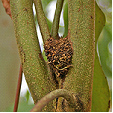 Dieback Borer Damage
Dieback Borer Damage
Dieback Borer (Platyomopsis armatula) adult is a grey-brown beetle up to 20mm long with small lumps on its wing covers and long antennae. The 15mm long cream coloured larva tunnel under the bark and feed on the sapwood causing ringbarking. The entrance to the tunnel is covered in frass and plants in the Myrtaceae family such as Eucalyptus species are susceptible.
Elm Twig Girdler (Oberea tripunctata). The adult beetle feeds on twigs causing girdling then deposits eggs during spring. The lava tunnels down the centre of the stem from the girdled point and overwinters in the tunnels. Twigs up to 14mm diameter may snap off at the damaged point and Ulmus species are normally the host.
Mahogany Shoot Borer (Hypsipyla grandella). The adult is a greyish-brown moth with a wingspan up to 45mm with the wings and veins distinctly overlayed in black. It deposits oval eggs that are tiny 0.50mm wide normally deposited in the leaf axil and change colour from white to red in the first 12 hours. In 3 to5 days the larvae emerges and can grow to 25mm long and is brownish white when young and maturing to bluish with a brown head capsule. Swietenia species are damaged as the larvae bore into the new shoots normally during spring or during the rainy season. The shoots and branches wilt then collapse. This is a major economic pest for cultivated trees.
Red Cedar Tip Moth (Hypsipyla robusta) adult is a grey moth with a wing span up to 20mm across and produces fleshy lava with true legs up to 20 mm long that tunnels into the tips of twigs. The tunnels are surrounded by webbing that is littered with pelleted droppings and is normally found on Toona species.
Staghorn Borer larvae grow to 15mm long and are greyish with true legs and the grey adult moth has a wingspan up to 20mm across. It attacks Platycerium species by eating tunnels into the sterile fronds.
Appearance and Distribution of the Pest
They are found mainly on the coast but also inland and are distributed by flying with the assistance of wind.
Life Cycle
These insects have a Holometabolous life cycle, ie. When metamorphosis is observed during the pupal stage.
Eggs are laid in bark on the growing tips. Larvae shelter in tunnels they create in the wood, up to 20mm deep.
Period of Activity
Active throughout the year in warm climates and are commonly found from tropical to sub-tropical and temperate regions.
Damage Caused
Generally the symptoms of tip borers is yellowing and curling of the leaves which wilt then die or shoots become blackened and are noticeable in the tree. Extensive feeding by a number of larvae causes dieback but normally, this is a minor pest.
The larvae emerge from their tunnels at night, to feed on the bark around the entrance holes. Entrance holes are covered by a layer of chewed wood fragments ("frass") and silk webbing. Most damage appears on twigs and new growth.
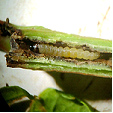 Typical larvae
Typical larvae
The Callistemon Tip Borer tunnels down the centre of the twigs causing then to die or break off and the Macadamia Twig Girdler (Neodrepta luteotactella) form tunnels in sapwood that are covered in fine webbing that is dotted in brown excreted pellets. This is the same appearance as the Banksia Web-covering Borer (Xylorycta strigata) larva makes, as it tunnels down the centre of shoots.
Susceptible Plants
Many native and ornamental plants are susceptible to tip borers such as Callistemon, Melaleuca, Banksia, Hakea, Macadamia and Stenocarpus species
Eucalyptus, Callistemon, Corymbia, Leptospermum and Melaleuca species are attacked by the Dieback Borer (Platyomopsis armatula). Twigs and small branches are attacked and the larvae causes ring bark. Affected branches break easily in high winds.
Sambucus, Yucca and Delphinium species are attacked the Common Stalk Borer (Papaipema nebris) which attacks the stems causing the plant to wilt and topple over.
Cultural Control
Larvae may be destroyed after exposure by pulling away the covering pad of frass, or by pushing a length of wire into the tunnel. Damaged branches may be removed, or tunnels plugged. Infested perennials or annuals should be removed and destroyed.
Biological Control
No effective biological control.
Chemical Control
Spray with Carbaryl (including the trunks or stems) if necessary while the insects are active.
Note
Always read the label for registration details and direction of use prior to application of any chemicals.
PEST
NAME
Scale Insect
Various Scale Species
ORDER
Hemiptera
Description of the Pest
Generally scales are soft bodied insects that have a hard (armoured) or soft covering to hide under. They have piercing and sucking mouth parts that are attached to the host, feed off sap and soft scales commonly producing sweet honeydew, which in turn attracts sooty mould and ants.
The adult female has a circular or oval covering depending on the species and is up to 8mm across. The first stage (crawlers) hatch and wander around the leaf surface until finding a suitable place to suck sap, normally in colonies and the smaller male is relatively inconspicuous.
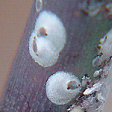 Hard Scale
Hard Scale 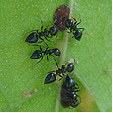 Soft Scale, attending Ants
Soft Scale, attending Ants
Cactus Scale (Diaspis echinocacti) has a circular greyish female and a narrow white male scale and is commonly found on house plants.
Chain Scales (Pulvinaria species) adult females are obvious with large group of eggs that are white or cottony-like, and the tiny young light green scales are flat and oval-shaped up to 2mm long. The legged nymphs are normally arranged from head to tail along the mid rib of the leaf, and may move to a new position to feed. They excrete honeydew and attract sooty mould and are found on Acacia and Acronychia species.
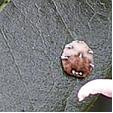 Chinese Wax Scale
Chinese Wax Scale
Chinese Wax Scale (Ceroplastes sinensis) is a domed wax scale that has dark spots around its margin and immature scales form waxy material around there margins.
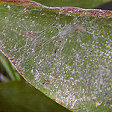 Fern Scale on Aspidistra elatior
Fern Scale on Aspidistra elatior
Fern Scale or Coconut Scale (Pinnaspis aspidistrae) appears as flecks up to 0.15mm long with a white covering over the male congregating on the underside of the fronds on the axils and among the sporangia causing them to turn yellow. Many species of fern are susceptible to infestation.
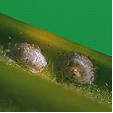
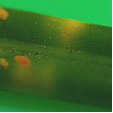 Flat Brown Scale
Flat Brown Scale
Flat Brown Scale (Eucalymnatus tessellates) are light brown up to 0.5mm long, flat and closely attached both sides of the leaf and causing yellowing of the foliage.
Juniper Scale (Diaspis carueli) is tiny and circular, white maturing to grey-black and as it feeds the needles turn yellow and die.
Oleander Scale (Aspidiotus hederae) is a pale yellow circular scale up to 3mm across and is found in dense colonies on the stem or leaves.
Tea-tree Scale (Eriococcus orariensis) are a creamy blue colour normally packed along the branches and are plump and rounded to 4mm across.

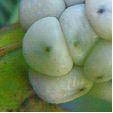 Wattle Tick Scale
Wattle Tick Scale
Tick or Wattle Scale (Cryptes baccatus) adult is domed, blue-slate colour with a leathery covering up to 10mm long. All stages of growth are found in groups of over forty, packed along the stems and normally tended by ants as they produce large amounts of honeydew. A serious pest of Acacia species found inland or coastal from temperate to sub tropical climates and commonly accompanied by Sooty Mould.
Toxic Scale (Hemiberlesia lataniae) is a tiny flat rounded scale up to 0.15mm long and is white to pale pink. It is normally found in colonies on the small branches and twigs of shrubs. It injects a toxic substance into the host as it sucks sap causing the death of the branch.
Wattle Scale (Pseudococcus albizziae) is soft, plump and secrets cotton-like threads. It is not a true scale insect and is simular to mealy bugs. It is reddish-brown up to 0.4mm long and secrets large amounts of honeydew as it sucks sap in colonies along the branches.
Life Cycle
These insects have a Hemimetabolous life cycle, ie. When the immature nymphs resemble the adults.
Appearance of the Pest
All parts of the plant above the soil may be attacked, but normally the stems and leaves and scale tends to favour well-lit positions.
Period of Activity
The nymphs and females are active for most of the year, in warm climates. Once they selected a position they attach and don't move. Normally the winged or wingless males are mobile and only soft scales produce honeydew.
Susceptible Plants
There is a wide range of susceptible plants including citrus, willows, holly, and many ornamentals, such as roses or Paeonia species. It also attacks indoor or glasshouse plants and Australian native plants such as wattles, hakeas, grevilleas and eucalyptus.
Acacia species are attacked by the Tick or Wattle Scale, which infest twigs and small branches and heavy infestations will kill the host plant.
Acer species are attacked by the Cotton Maple Scale (Pulvinaria innumerabilia) which prefers Acer saccharinum. Nymphs first attack the leaves and the brown adult scale is covered in a woolly mass up to 14mm across, normally found on the underside of the stems and twigs.
Acmena smithii, Melaleuca, Syzygium and Pittosporum species are attacked by the Chinese Wax Scale.
Aesculus species are attacked by several scale insects including the Walnut Scale (Aspidiotus juglans-regiae) which is saucer-shaped and attacks the main trunks.
Agave species are susceptible to several types of scale including (Aspidiotus nerii), (Aonidiella aurantii) and (Pinnaspis strachani), but generally do not require control.
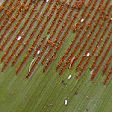 Asplenium australasicum
Asplenium australasicum
Asplenium australasicum is susceptible to Coconut Scale or Fern Scale (Pinnaspis aspidistrae). It is normally found on the under side of the fronds. Small infestations cause little damage.
Bougainvillea species may be attacked by the soft scale (Coccus hesperidum) outdoors or under glass.
Calluna and Vaccinium species are attacked by the Oyster Shell Scale (Lepidosaphes ulmi).
Camellia species may be attacked by the Florida Red Scale (Chrysomphalus aonidum), which is small, circular and black and is found firmly attached to the underside of the leaf along the veins. On inspection after removing the scale the insect has a pale yellow body. Camellias are also attacked by a large variety of scale insects including Tea Scale and Camellia Scale.
Carpinus species may be attacked by the scale (Phenacoccus acericola). It is found on the underside of the leaves forming a white cotton-like clump along the veins.
Casuarina and Allocasuarina species may be attacked by the Casuarina Scale (Frenchia casuarinae), a black hard scale that is upright to 4mm with a pinkish body. During attachment the surrounding tissue swells up and in time can, form galls. This weakens the wood and in severe infestations may kill the tree.
Cotoneaster species are attacked by up to four species of scale including the Oyster Shell Scale (Lepidosaphes ulmi).
Cupressus species are attacked by Bark Scale (Ehrhornia cupressi) is pink and covered in white wax. Heavy infestations cause the leaves to turn yellow or reddish.
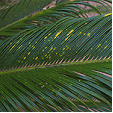 Flat Brown Scale on Cycas revoluta
Flat Brown Scale on Cycas revoluta
Cycads, palms and some species of Callistemon are attacked by the Flat Brown Scale.
Erica species are attacked by several species of scale including, Greedy, Oleander and Oystershell scale.
Jasminum species can be infested with up to twelve types of scale.
Juniperus x media and other conifer species are attacked by the Juniper Scale.
Leptospermum species are attacked by the Tea-tree Scale which produces ample honey dew that promotes sooty mould.
Palm and Fern species are susceptible to attack by the Coconut Scale or Fern Scale (Pinnaspis aspidistrae) which infests the underside of the leaves. They are also hosts for many other scale species such as red, cottony cushion and tea scale.
Pinus species are attacked by several species of scale including the Pine Tortoise Scale (Toumeyella numismaticum) and the Red Pine Scale (Matsucoccus resinosae).
Polygonum odoratum is attacked by a small brown scale.

Sorbus aucuparia is attacked by a five species of scale insect, including Black Cottony Maple, San Jose and Scurfy. Generally they suck on the sap of the new growth and leaves.
Strelitzia species are attacked by the Greedy Scale (Aspidiotus camelliae).
Damage Caused
Leaves become yellow and are shed prematurely and there may be twig or stem die-back. When the infestation occurs on fruit, the fruit is small and its skin becomes pitted and cracked. Small trees and saplings that are heavily infested may be seriously damaged or die. Sooty mould can cover fruit or leaves causing a secondary problem.
Cactus Scale can completely cover the host cactus sucking sap and causing it to die.
Cultural Control
Dead or damaged parts of the plant should be removed and destroyed including fallen fruit. Small infestations may be removed by hand or squashed on the stems. Healthy plants are less susceptible to attack, so maintain vigour of the plant and avoid using high-nitrogen fertiliser that produces excessive soft young growth.
When pruning susceptible plants paint the cuts with antifungal sealant paint as scale insects are attracted to the sweet smell of the sap. This will reduce the infection rate of the plant.
Biological Control
Natural predators such as parasitic wasps may reduce numbers of active nymphs; parasitic wasps are bred commercially in some areas for this purpose. It should be noted, however, that wasps would avoid dusty conditions.
Other predators that assist in control are assassin bugs, ladybirds, lacewings, hover flies and scale eating caterpillars. A variety of birds also attack scales.
The control of ants that transport aphid from one host to another also reduces infestation and can be carried out by applying at least three greased bandages 5mm apart around the stem or trunk of the plant.
Chemical Control
Spray the entire plant with dilute white oil solution; a follow-up spray may be required after four weeks, for heavy infestations. Spraying of chemicals will also kill of natural predators and in some cases the secondary scale infestation is more prolific especially when using copper based chemicals.
Some chemical controls, such as methidathion, are available - please seek advice from your local nursery as to the suitable product for your area.
Note
Always read the label for registration details and direction of use prior to application of any chemicals.
PEST
NAME
Leafminer (General)
Various Leafminer Species
Description of the Pest
There is a wide range of insects that have larvae, which mine leaves and these are found throughout the world. These include beetles, wasps, sawflies, moths and flies. The larvae may or may-not have legs, but are normally flattened.
These insects have a Holometabolous life cycle, ie. When metamorphosis is observed during the pupal stage.
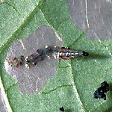 Typical Leafminer
Typical Leafminer 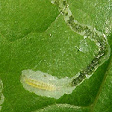
Cigar Case Bearer (Coleophora caryaefoliella) adult is a brown moth with fringed wing margins up to 9mm across. The tiny lava has a black head and feed beneath the epidermal layer of the leaf and over winters in small cigar-shaped cocoon. Commonly found on Carya species.
Cineraria Leaf Miner (Chromatomia syngenesiae) is in the family Agromyzidae. This insect has a complete metamorphosis: egg, larva, pupa and adult. The adult is a small (2mm) black fly. Female adults puncture the undersides of leaves to feed on the sap. Cream coloured larvae (maggots) are miners, up to 5mm long, and their tunnels appear as a tracery of irregular white lines on the leaves, through which the larvae will be visible on the lower surfaces. The pupa is darker-coloured, barrel-shaped and up to 2.5 mm in length.
The feeding of females causes small rust-like spots to appear on the upper surface of leaves. The eggs are deposited on the undersides of the leaves. The tunnels of the larvae become wider as the insect grows and may eventually cause the infested foliage to wilt. Heavily infested plants will die; more often, the appearance of the plant is spoilt by the disfigured leaves, even though it will still produce flowers.
Cypress Moth (Recurvaria apicitripunctella) female adult is a small, yellowish with fringed wings and black markings. The larva tunnels into leaves and then ties them together with silken web, it found on Taxodium mucronatum.
Grevillea Leaf Miner (Peraglyphis atimina) a tiny larvae that eats the inner tissue of leaves and forms tunnels that expand as they grow.
The Leaf Miner (Epinotia nanana) is an olive green caterpillar with a brown head that attacks the base of the leaf and webs them together as it progresses. It is found in Tsuga species.
The Leaf Miner (Lithocolletis crataegella) lava forms tunnels in the inner tissue of the leaf, which becomes wider forming blisters that turn light brown. It normally occurs during late spring attacking unfolded leaves of many plant species including Crataegus.
Macadamia Leaf Miner (Arocercops chionosema) larva forms tunnels that lead to blisters in the leaves and the adult moth is brown with silver bands.
Damage Caused
There is a range of symptoms as a result of attack. Damage appears initially as tunnels on the underside of the leaves, which become broader. The leaf may form blisters and turn a rusty colour with patches visible on both sides. Continual feeding can cause the leaf to fall prematurely and give the plant an unattractive appearance. This attack is a serious problem in a forestry situation but is normally insignificant in a domestic garden. Attacks may be sporadic.

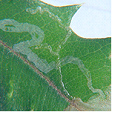 Banksia integrifolia
Banksia integrifolia
Cineraria Leaf Miner
Tunnels begin to appear in early spring and continue through early summer, particularly during cooler, humid periods. The adult fly is inconspicuous and tends to go unnoticed - its presence is indicated by the appearance of the rust-like spots on the leaves as described above. Tunnels of larvae, in which the maggot pupates, may become up to 2mm wide and cover most of the surface of the foliage.
Period of Activity
The larvae are active from summer to autumn and are found from the tropics to temperate regions and generally the eggs are laid on the underside of leaves.
Susceptible Plants
There is a wide range of ornamentals and native plants that are attacked by leaf miners, including vegetables, perennials, annuals, shrubs and trees such as Nyssa sylvatica.
Aquilegia species leaves are attacked by the leaf miner (Phytomyza minuscula) which causes obvious winding white tunnels across the leaf surface.
Betula species are attacked by the leaf miner (Fenusa pusilla). The small black sawfly emerges from the soil primarily during spring. The small worm-like white lava feeds on the fresh new growth, and may cause substantial damage. Adults that emerge later in the season cause less destruction as the lava ignore mature leaves feeding only on new growth.
Buxus species are attacked by the leaf miner (Monarthropalpus buxi) that causes water soaked areas on the underside of leaves as the lava tunnels beneath the epidermal layer.
Cornus species are susceptible to the leaf miner (Chalepus dorsalis) yellowish lava up to 7mm long that tunnels the leaves causing blisters and the adult beetles skeletonise the underside of the leaves.
Leucanthemum and Dendranthema species are attacked by the Chrysanthemum Leaf Miner (Phytomyza atricornis).
Macadamia species and Stenocarpus salignus are attacked by the Macadamia Leaf Miner.
Pericallis x hybridus (Cineraria) is attacked by the Cineraria Leaf Miner (Chromatomia syngenesiae). Leafy vegetables are also susceptible, as are plants in the Asteracea family and related ornamentals such as chrysanthemums, nasturtiums, and gerberas. Sow thistle and other leafy weeds are hosts for this insect. The foliage becomes covered with unsightly, tortuous silvery lines which ultimately ruin the appearance of the plant. Heavy infestations cause wilting and death of the plants. Do not take cuttings from affected plants.
Verbena species are attacked by the leaf miner (Agromyza artemisiae), which mines the leaf margins.
Cultural Control
It is difficult to control leaf miners and damaged leaves may be removed then destroyed from localised infestations.
Biological Control
Many leaf miners are attacked by parasitic wasps and small birds which reduces numbers.
Chemical Control
Chemical treatment includes spraying with dimethoate; note that it is advisable to treat the plants before the larvae pupate and being certain to cover the new growth avoiding reinfestation.
Note
Always read the label for registration details and direction of use prior to application of any chemicals.
PEST
NAME
Hawk Moth
Various Hawk Moth Species
ORDER
Lepidoptera
FAMILY
Sphingidae
Description of the Pest
Adults have a characteristic "delta winged" shape when at rest; wings may be twice as long as the body. Adults have a long siphoning proboscis; larvae have chewing mouth-parts. Colours of both the larvae and adults are variable, according to the species, and the food plant. Larvae are large, fleshy caterpillars, usually having a stiff spine at the end of the body.
Cissus Hawk Moth (Cizaria ardeniae), adult is a large moth with greenish forewings and the large fleshy lava is a brownish caterpillar up to 100mm long with a prominent spine on its tail. The lava may feed solitary or in small groups on leaves leaving only the midrib. Commonly found from tropical to sub tropical regions.
Doubleheaded Hawk Moth (Coequosa triangularis) is a brown moth with a wing span up to 150mm across and produces a large green larva with yellow strips up to 120mm long. It is a solitary feeder eating entire leaves and is found from tropical to sub tropical regions.
 Privet Hawk Moth larvae
Privet Hawk Moth larvae 
Image by B. Sonsie
Privet Hawk Moth (Psilogramma menephron) adult is brownish up to 80mm across with narrow wings and the fleshy lava is a caterpillar up to 100mm long with dark oblique bands on its sides. The caterpillars may feed solitary or in groups consuming large amounts of foliage leaving only the mid rib of the leaves and depositing barrel-shaped faeces.


Appearance and Distribution of the Pest
Larvae appear during the warmer months and depending on the species they are found from tropical to temperate regions.
Life Cycle
These insects have a Holometabolous life cycle, ie. When metamorphosis is observed during the pupal stage.
Larvae drop to the ground to pupate in the soil or in leaf litter. Adults feed on nectar and cause little damage.


Period of Activity
These moths are indigenous to Australia and are active in spring and summer.
Damage Caused
The hawk moth is not normally a pest; unusually heavy larval infestations may defoliate a plant rapidly.
Susceptible Plants
Many soft-foliaged plants are susceptible, including ornamentals and fruit trees.
Cissus and Grevillea species are susceptible to the Cissus Hawk Moth (Cizaria ardeniae).
Ligustrum and Jasminum species are attacked by the Privet Hawk Moth (Psilogramma menephron).
Persoonia, Banksia and Macadamia species are attacked by the Doubleheaded Hawk Moth (Coequosa triangularis).
Cultural Control
Remove by hand and squash.
Biological Control
There is no significant biological control.
Chemical Control
Contact insecticide is effective, but seldom necessary.
Note
Always read the label for registration details and direction of use prior to application of any chemicals.
PEST
NAME
Painted Apple Moth
Teia anartoides
ORDER
Lepidoptera
FAMILY
Lymantriidae
Description of the Pest
Adult males are 25mm long and have a 25mm wingspan, with brown forewings and yellow hindwings with black edges. Females are also 25mm long, but wingless. Larvae are furry brown caterpillars, up to 30mm long, with four prominent tufts of reddish brown hair behind the head, and two horn-like tufts of black hair projecting forward. The caterpillar's hair may cause skin irritation.
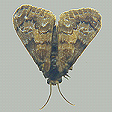
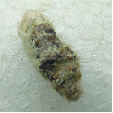 Wingless Female
Wingless Female
Appearance and Distribution of the Pest
An Australian native, most commonly found in temperate and subtropical regions. Originally known as the painted wattle moth, feeding exclusively on acacias, it has adapted to feed on apples and other species.
Life Cycle
This insect has a Holometabolous life cycle, ie. When metamorphosis is observed during the pupal stage.
Larvae pupate in loosely woven cocoons; eggs are laid on the empty cocoons.
Period of Activity
May be active all year, particularly during the cooler months.
Damage Caused
Larvae may skeletonise leaves; small plants may be defoliated. Because females are flightless, infestations are localised.
Susceptible Plants
A wide range of plants are affected, including apples, Acacias, Melaleucas, Grevilleas, and many exotics. Some fern species are also attacked.
Rosa species leaves are attacked by larva.
Cultural Control
Remove small infestations of larvae and cocoons by hand.
Biological Control
None known.
Chemical Control
Maldison, Carbaryl or other contact pesticides are effective; a wetting agent is necessary to penetrate the larval hair.
Note
Always read the label for registration details and direction of use prior to application of any chemicals.
Note: Plants affected by this pest are Deer Resistant plants not the susceptible plants.
PEST
NAME
Deer
Cervus species
ORDER
Artiodactyla
FAMILY
Cervidae
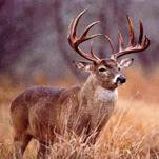
Description of the Pest
There are two species of the deer in North America, the Whitetail (Odocoileus virginianus) and the Mule deer (Odocoileus hemionus) with several regional variations such as the Pacific coastal Blacktail (O.h. columbianus) which is regarded as a sub-species of the Mule deer.
The Whitetail on average grows to 112 cm (44in) tall and 180 mm (70 in) long and weigh 68 kgs (150lbs). The fir colour varies according to its environment but generally it is reddish-brown during summer and grey-brown in winter with a pure white underside on its tail. When the tail is erect it is known as the "white flag". Its antlers consist of two main beams from which the points emerge.
The Mule deer grow to 105 cm (42 in) tall and are up to 200 cm (80 in) long with the adult buck weighing up to 137 kgs (300 lbs) and the does up to 80 kgs (175 lbs). The fir is generally tawny brown during summer and during winter it has a heaver grey-brown to blue-grey coat with a small white tail that is tipped in black. The other distinguishing features are its ears that are up to 300 mm (1 ft) long (mule-like) and its antlers, with the two beams that are forked into smaller beams, which inturn fork again and again.
The Blacktail deer (Pacific coastal Blacktail) grows to 97 cm (38 in) tall and is up to 105 cm (60 in) long and weighs on average 73 kgs (160 lbs). The fir is generally tawny brown during summer and during winter it has a heaver grey-brown to blue-grey coat with a tail that is dark brown at the base then changing to black for 50% of its length. The antlers consist of two beams that are forked into smaller beams, which inturn fork again and again.
Appearance and Distribution of the Pest
The Whitetail deer are found throughout eastern United States, on the coast and inland but are not commonly seen in California, Utah or Nevada. They do not migrate but congregate together (yard up) during winter and feed in a part of their existing territory.
The Mule Deer are found in the western part of North America from South eastern Alaska to Mexico and from the Pacific coast to Texas. They migrate from highland mountain meadows to southern or lower snow free forested valleys during winter.
The Blacktail deer are found on the Pacific coast from Alaska to northern California. There is both resident and migratory Blacktails. The migratory Blacktails move southwards during late autumn at the first sigh of snow or heavy sustained rain and the resident Blacktails seek cover their existing territory amongst woodlands during the winter months.
Life Cycle
All Deer breed from autumn to early winter and the does give birth from late spring to early summer.
Period of Activity
Deer are most active from spring to autumn but can be troublesome during winter when the feed is scarce. In some regions urban landscapes become the major food source both in summer and winter.
Damage Caused
Browsing deer will feed on almost any plant and is most commonly noticeable during spring feeding on the new growth or twigs and stems leaving a shredded appearance. Deer also rub their antlers against trees damaging bark and snapping off small branches, this action also incurs damage under hoof as plants, lawns and garden structures are trampled on.
Susceptible Plants
Some plants are more palatable to deer but when a deer is hungry or during drought conditions there are no "Deer Proof" plants. There is a range of plants that have a bad taste and are not destroyed and are regarded as (deer resistant plants). Deer resistant plants are the plants that are attached to this file not the susceptible plants.
Cultural Control
There are many cultural controls that have been tried to move browsing deer such as frightening them with strobe lights, pyrotechnics or tethered savage dogs. These actions are only temporary and may cause more trouble as the stampeding animals move off. Fencing and netting can be an effective method of discouraging hungry deer from gardens but may be expensive on a large scale and require maintenance. There are several types of fences which include conventional 2.2m (8 ft) deer-proof woven wire fences or single-wire electric fences and slanted deer fences. Plant selection can also be effective, by using less desirable plants (deer resistant plants) as an outer border to the more desirable plant species and thus discouraging the deer to enter the garden. Hedges and windrows of less desirable thorny plants can also be a deterrent to browsing deer.
Chemical Control
There are two main types of repellents contact and area. Contact repellents are applied directly to the plants and deter deer with a bad taste or smell. They can be applied by rubbing or spraying on to the plants and commonly used in an egg mixture. The commercial products have proven to work better than home remedies which include soap or chilli mixtures and hanging bags of human hair.
Area repellents rely on an offensive odour and are placed around areas that are frequently visited.
Contact your local distributor for available types and application.
DISEASE
NAME
Leaf Spot (General)
Various Leaf Spot Species
Description
There is a wide variety of fungal leaf spots that infect perennials, shrub and trees. Some are specific to the host while others can affect a range of plants.
Symptoms
Generally light brown to purplish or blackish spots appear on the leaf and form concentric rings of fruiting bodies. The spots may leave holes, perforating the leaf or expand with pale green to yellowish margins and when the holes merge the leaf normally dies. There are many different types of leaf spot, some are discussed below.
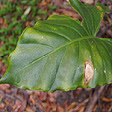 Alocasia species
Alocasia species 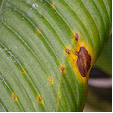
Alternaria Leaf Spot (Alternaria nelumbii) forms a small reddish brown spots that are boarded in light green, and as they develop in size the leaf curls and dies from the margin inwards. Normally occurs on Nelumbo species (water lilies).
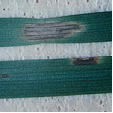 Helminthosporium Disease
Helminthosporium Disease
Helminthosporium Disease (Bipolris species), (Drechslera species) and (Exserophilum species) are responsible for several leaf spots that occur on all Turf Grass species. Generally they form black or white spots that may be faded and produce masses of spores in the thatch during late summer, under humid conditions. The life cycle is short and when conditions are favourable spores are splashed onto the foliage from the thatch, causing wide spread infection. Cynodon dactylon (common couch) is most susceptible and found in bowling or golf greens where it is a serious problem.
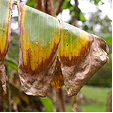 Banana Leaf Spot
Banana Leaf Spot 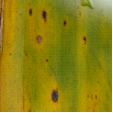
Banana Leaf Spot (Mycosphaerella musicola) is found on many species of banana causing pale yellow streaks on the young leaves to turn brown with dark spots. The leaf then becomes dried, brown and dead commencing from the margins, eventually the leaf dies. Control requires removal of infected foliage or the spraying of a fungicide and fungicides should not be used during the fruiting period.
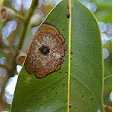
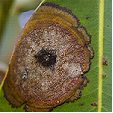 Lophostemon confertus (Brush Box)
Lophostemon confertus (Brush Box)
Leaf Spot on Brush Box (Elsinoe species). This is a casual fungus that attacks the epidermal layer of the leaf, forming circular spots that are up to 25mm across and are often restricted by the main vein. These spots are a dull yellowish brown but can also have purplish patterns. A leaf may have more than one spot develop on its surface and normally appears on scattered leaves throughout the tree. This doesn't affect the vigour of Lophostemon confertus.
Palm Leaf-scab (Graphiola phoeicis) appears as yellow spots and develop into scabs or warts that are outwards hard and dark but with a soft centre with powdery yellowish brown spores. The infected leaves eventually die.
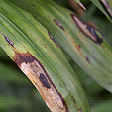 Palm Leaf Spot, Chamaedorea elegans
Palm Leaf Spot, Chamaedorea elegans
Palm Leaf Spot (Pestaloptiopsis species) appears as a small spot with a dark centre on the leaves and affects palms that are growing in shaded humid positions and normally control is not required, though infected fronds should be removed.
Source and Dispersal
Infection source is other contaminated plants and the spores are spread by wind or by splashing water. The fruiting bodies are black spots that appear on the damaged tissue releasing spores.
Favoured Conditions
This fungus prefers a warm humid environment and leafy plants with soft new growth, particularly if they are crowded.
Affected Plants
There are many ornamental and native plants that are hosts to a wide range of fungal leaf spots. Some specific ones are listed below. Plants such as Cornus or Paeonia species are infected by a large variety of leaf spots, while other plants attract a specific leaf spot.
Generally a healthy plant can tolerate fungal leaf spot attack, though it may make the plant look unsightly. In trees and shrubs it is difficult to control and generally not necessary, but in perennials and annuals control may be necessary in order to save the plant.
Acalypha and Arctotis species are infected by up to three leaf spots including (Cercospora acalyphae) and (Ramularia acalyphae) that rarely require control.
Acer species are infected by Purple Eye (Phyllosticta minima) which forms spots with brownish centres and purplish margins causing the death of the leaves.
Acer species are also infected by Tar Spot (Rhytisma acerinum) which forms round black spots that have yellow margins. Not normally seen on cultivated trees, but seen in forests.
Adiantum, Asplenium, Blechnum, Cyathea, Davallia, Nephrolepis, Platycerium, Polypodium and Pteris species are infected by the leaf spot (Pseudocercopora species) which forms circular brown spots on the fronds and heavy infection can defoliate a plant.
Aesculus species are occasionally infected with the leaf spot (Septoria hippocastani) which forms small brown spots.
Agave species are susceptible to the leaf spot (Coniothyrium concentricum), which appear as greyish spots up to 20mm (1in) across with concentric rings and black fruiting bodies. Affected leaves are destroyed as the infection spreads.
Albizia julibrissin is susceptible to the fungal leaf spot (gloeosporium aletridis), which does not normally require control.
Amelanchler, Chaenomeles, Crataegus and Rhaphiolepis species Mespilus germanica are infected by the leaf spot (Fabraea maculata) which may cause considerable damage during wet periods.
Aquilegia species can be infected by three types of Leaf Spot including (Ascochyta aquilegiae), (Cercospora aquilegiae) and (Septoria aquilegiae), normally appearing during humid conditions forming spots on the leaves.
Arbutus species are infected by two leaf spots (Septoria Unedonis) which produces small brown spots on the leaves and (Elsinoe mattirolianum).
Arctostaphylos manzanita is infected by the leave spot (Cryptostictis arbuti) which damages leaves but is not normally detrimental to the shrub.
Aspidistra species are infected by the leaf spot (Colletotrichum omnivorum) causing whitish spots on the leaves and petiole.
Aster species are infected by many leaf spots including (Alternaria species), (Cercosporella cana), ( Ovularia asteris) and (Septoria asteris).
Aucuba species are infected by several leaf spots, usually as a secondary infection after aphid attack. These include (Phyllosticta aucubae) and (Phyllostica aucubae).
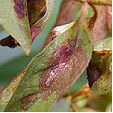
 Azalea
Azalea
Azalea (Rhododendron species) are susceptible to Leaf Scorch (Septoria azalea). This fungal disease forms reddish- brown spots which expand and engulf the leaf, with fruiting bodies appearing in the centre. Infected leaves die, then fall and the branchlets wilt. This problem is more serious during wet periods and may require control using a fungicide.
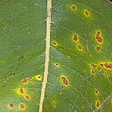 Banksia robur
Banksia robur
Banksia species are infected by several leaf spots causing chlorotic areas that have brown centres and is not normally a major problem for the plant.
Betula species may be infected by the Leaf Spots (Gloeosporium betularum) that forms brown spots with darker margins and (Cylindrosporium betulae) that also forms brown spots with faded indefinite margins.
Bougainvillea species are infected by the leaf spot (Cercosporidium bougainvilleae) which forms rounded spots with dark margins that yellowish ting. Infected leaves die and fall from the plant.
Calendula species are infected by the Leaf Spot (Cercospora calendulae) which rapidly infects the plant spotting the leaves and killing the plant.
Callicarpa species may be infected by the leaf spot (Atractilina callicarpae) forming irregular brownish spot or (Cercospora callicarpae) which can defoliate the plant in subtropical climates.
Campsis species may be infected by several fungal leaf spots including (Phyllosticta tecomae), (Septoria tecomae) and (Cercospora duplicata).
Carpinus species are infected by the leaf spots (Gloeosporium robergei), (Gnomoniella fimbriata) and (Septoria carpinea), all are minor infections not normally requiring control.
Carya species are infected by several leaf spots including (Gnomonia caryae) that infects leaves with irregular reddish spots on the upper surface with corresponding brown spore producing spots on the underside. It also has a secondary spore release that occurs on the dead leaves where it over winters. Other leaf spots include (monochaetia desmazierii) and (Marssonina juglandis).
Ceanothus species are susceptible to the leaf spot (Cercospora ceanothi) and (Phyllosticta ceanothi) both are of minor importance not requiring control.
Celtis species are infected by many leaf spots including (Cercosporella celtidis), (Cylindrosporium celtidis), (Phleospora celtidis) and (Septogloeum celtidis).
Chrysanthemums species are infected by the leaf spot (Septoria species) which forms yellow spots appear toward the edge of the leaves; these become enlarged brownish patches with yellow margins. Damaged areas may converge and in severe attacks and the leaves may fall prematurely or flower production is reduced.
Clematis species are infected by the fungal disease (Ascochyta clematidina) which may cause stem rot or leaf spots that are water soaked areas with reddish margins. The infection spreads from the leaves to the stem causing wilting and eventually girdling the stem killing the plant. There are many fungal leaf spots that infect this plant including (Cercospora rubigo) and (Septoria clematidis)
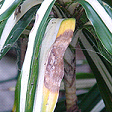 Dracaena deremensis
Dracaena deremensis
Cordyline and Dracaena species may be infected by the leaf spot (Phyllosticta maculicola) which forms small brownish spots that have yellowish margins and has black fruiting bodies that forms coils of spores. These plants are also susceptible to other leaf spots such as (Glomerella cincta) and (Phyllosticta dracaaaenae). Keep foliage dry to avoid infection.
Cynodon dactylon, Pennisetum clandestinum and many other Turf Grasses are susceptible to Helminthosporium Disease.
Daphne species are infected by the leaf spot (Gloeosporium mezerei) and (Marssonina daphnes) both of which form thickish brown spots that are seen on both sides of the leaves. Infected leaves turn yellowish before dieing.
Dendranthema species are infected by many leaf spots such as (Septoria chrysanthemi) which first forms yellowish spots up to 25mm (1in) across that become black. Infected leaves die prematurely and persist on the plant.
Dianthus species may be infected by the leaf spot (Septoria dianthi). It forms light brown rounded spots that have a purplish border. The scattered spots on the lower leaves can also be found on the stems and the spores are dispersed by water from the tiny black fruiting bodies.
Dieffenbachia species are infected by several leaf spot fungi including (Cephalosporium species) and (Myrothecium species).
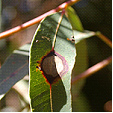 Eucalyptus species
Eucalyptus species
Eucalyptus species are infected by many fungal leaf spots such as (Mycosphaeralla species), (Hendersonia species) and (Monocheatia monochaeta). Generally leaf spots appear on the juvenile or new leaves causing brownish spots that enlarge and may have a purplish halo around the margin. Mature adult leaves are not normally infected and the trees rarely require control measures.
Fern species are infected by the leaf spot, (Alternaria polypodii). This fungus appears as brown circular or oblong spots that congregate along the margins of the pinnae causing the fronds to turn brown and die. It is spread by wind currents from plant to plant and control methods include removing infected fronds and maintaining a drier atmosphere.
Ficus species are infected by various fungal leaf spot including (Pseudocercospora species). Generally the fungal attack forms circular or irregular dark coloured spots on the leaves eventually causing them to fall prematurely.
Ficus elastica is susceptible to many fungal leaf spots including (Alternaria species), (Leptostromella elastica) and (Phyllosticta roberti).
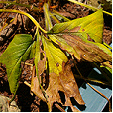
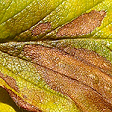 Strawberry
Strawberry
Fragaria x ananassa (Strawberry) is infected by the fungal leaf spot (Mycospharella fragariae). The mature leaf is initially infected with well defined brown spots that that turn light grey with red-purplish margins. As the spots merge they form large brown blotches and the leaf turns yellow then dies. This fungal attack normally occurs on plants in poor health and can be a serious problem early in the season seriously damaging stock.
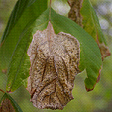 Fraxinus species
Fraxinus species
Fraxinus species are infected by the leaf spot (Gloeosporium aridum) giving the leaf a scorched appearance as large blotches appear from the margin or apex and turn brown with a papery texture. It is more prevalent during rainy periods and infected leaves fall prematurely. Collect and depose of fallen leaves otherwise control is not normally required.
Fuchsia species may be infected by the leaf spot (Septoria species) or ( Cercospora species), both form spots with dead centres and dark margins.
Gladiolus species are infected by Hard Rot or Leaf Spot (Septoria gladioli). On the corms reddish brown circular water soaked spots become large and sunken. These areas dry out and form obvious margins. The leaves may also have these symptoms but is not commonly seen.
Hemerocallis species are infected by several leaf spots including (Cercospora hemerocallis) and (Heterosporium iridis). These may be in the form of black spots or brownish spots that converge killing the leaf. Infected leaves should be removed and burnt.
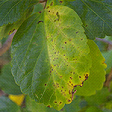 Hibiscus species
Hibiscus species
Hibiscus rosa-sinensis, Hibiscus syriacus and Hibiscus tiliaceus are susceptible to several fungal leaf spots including (Ascochyta abelmoschi), (Cerospora kellermanii) and (Phyllosticta hibiscina). All cause spotting or blotching of the leaf surface; remove and destroy infected parts.
Hydrangea species are infected by four fungal species including (Ascochyta hydrangeae), (Phyllosticta hydrangeae) and (Septoria hydrangeae).
Iris species are infected by several fungal leaf spots including (Alternaria iridicola) and (Macosphaerella species).
Iris species are also infected by the leaf spot (Didymellina macrospore) that forms greyish spots with brown water soaked borders and coalesce on the upper part of the leaf. This casual organism commonly occurs after flowering killing the leaves but will not infect the bulbs. The bulbs become weak over several seasons due to the decreased foliage.
There is also a Bacterial Leaf Spot (Bacterium tardicrescens) that is commonly mistaken as a fungal problem causing translucent spots that coalesce and involve the entire leaf. Normally found on Iris species.
Laburnum anagyroides is infected by the Leaf Spot (Phyllosticta cytisii). The leaf forms light grey spots with no definite margin and mature to brown. The black fruiting bodies appear as dots in the centre of the spot.
Leucanthemum species are infected by the leaf spot (Cerocspora chrysanthemi) and (Septoria leucanthemi).
Magnolia species are susceptible to many species including (Alternaria tenuis), (Mycosphaerella milleri) and (Phyllosticta species). Leaves generally turn brown from the apex or margins turning brown or spots appear on the leaf surface and leaves become yellow before withering and dieing. Normally the make the tree look poorly but have little effect on its growth. Control is not normally required.
Nerium oleander is susceptible to several fungal leaf spots including (Cercospora nerella), (Cercospora repens), (Gloesporium species) and (Phyllosticta nerii). Infected leaves should be removed but generally control is not required.
Nyssa sylvatica is infected by the leaf spot (Mycosphaerella nyssaecola) forming irregular purplish blotches.
Orchids such as Cattleya, Cymbidium, Cypripedium, Dendrobium, Epidendrum, Paphiopedilum, Phalaenopsis and Zygopetalum species are infected by several leaf spots including (Cerospora, Colletotrichum and Phyllosticta species). Normally forming dark or dead, circular or irregular areas on the leaves.
Palms such as Syagrus, Howea, Phoenix, Roystonea and Washingtonia species are infected by Leaf-scab (Graphiola phoeicis).
Palms such as Archontophoenix, Caryota, Chamaedorea, Cocos, Dypsis, Howea, Liculia, Linospadix, Livistona, Phoenix, Ptychosperma, Rhapis, Roystonea, Syagrus, Washingtonia and Wodyetia species are susceptible to several fungal leaf spots including;
(Bipolaris spp.), (Cylindrocladium spp.), (Colletotrichum spp.) and (Pestalotiopsis spp.).
Generally the circular leaf spots are brown and may have a yellow halo such as Palm Ring Spot (Bipolaris incurvata). They vary in size from small to large depending on the species. When a plant is healthy it recovers from attack, but heavy infections can defoliate, causing the collapse of the plant.
Palms are also infected by the Brachybasidium Leaf Spot (Brachybasidium pinangae). This fungus forms angular leaf lesions that produce fruiting bodies on the underside and is commonly found on Archontophoenix species.
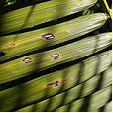
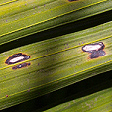 Archontophoenix cunninghamiana
Archontophoenix cunninghamiana
Passiflora species are infected with many types of leaf spot such as (Alternaria passiflorae).
Phoenix species are susceptible to False Smut (Graphiola phoenicis). This fungus forms yellow leaf spots that become hard with a raised with a blackish scab, which produces masses of powdery spores that are thread-like.
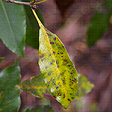
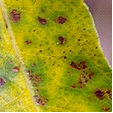 Pittosporum species
Pittosporum species
Pittosporum species are susceptible to the leaf spots (Alternaria tenuissima), (Phyllostica species) and (Cercospora pittospori). Circular or angular dark spots appear on the leaves and are surrounded by necrotic areas that are yellowish. Generally removal of infected leaves is adequate control.
Poa species and other cool season grasses are infected by Winter Fusarium Leaf Disease (Fusarium species), which causes small pale spots that are water soaked to appear on the leaves that turn red-brown. Infected leaves become bleached then wither and die, but the infection will not affect the crown or roots of the plant. It can be identified by pink, cotton-like mycelium and the plant prefers cold wet weather.
Populus species are infected by several fungal leaf spots including (Ciborinia bifrons, Ciborinia confundens), and (Mycosphaerella populicola).
Prunus species are infected by several leaf spots including (Cercospora circumscissa and Septoria ravenelii).
Pseudotsuga menziesii Douglas Fir is infected by the Leaf Cast (Rhabdocline pseudotsugae) Symptoms include the needles becoming yellowish at the apex and extending down the needle and spreading to others during moist spring weather turning them brown. Brownish scorched areas are noticeable on the tree from a distance. Control; is not normally required for mature trees but nursery stock may require spraying with a copper based fungicide.
Psidium guajava (Guava) is infected by (Glomerella cingulate). This fungus courses spots to appear on leaves and mummifies and blackens immature fruit or rots mature fruit. This fungus can devastate a guava crop.
Quercus species are infected by several types of leaf spot including (Cylindrosporium microspilum) and (Marssonina martini). These attacks tend top take place later in the season and normally not detrimental to the tree.
Rhododendron species are infected by a large variety of fungal leaf spots including (Cercospora rhododendri) and (lophodermium melaleucum)
Salix species are infected by several fungal leaf spots including (Ascochyta salicis) and (Septogloeum salicinum).
Senecio species are infected by the fungal leaf spot (Alternaria cinerariae) and (Cercospora species), forming dark rounded or angular spots.
Spiraea species are attacked by the fungal leaf spot (Cylindrosporium filipendulae).
Stenotaphrum secundatum (Buffalo) turf grass is susceptible to Grey Leaf Spot (Pyricularia grisea) in domestic and commercial situations devastating lawns. This fungal disease infects the stems and leaves with small brown lesions that enlarge rapidly forming grey-brown spots that have darker borders or surrounded by yellow chlorotic areas. This infection is commonly found on newly laid turf but will also infect established lawns. It is most prevalent during warm humid periods in soil with a high nitrogen level.
Syringa species are attacked by up to six species of leaf spot including (Cercospora lilacis) and (Phyllostica species).
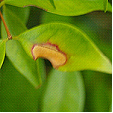 Syzygium species
Syzygium species
Syzygium species are infected by fungal leaf spots but normally control is not required.
Tagetes species are infected by the leaf spot (Septoria tageticola), which starts at the base and moves progressively up through the plant, covering the leaves in grey to black spots.
Trillium species are host to several leaf spots, including (Colletotrichum peckii) (Gloeosporium Trillii) (Heterosporium trillii).
Ulmus species are infected by many fungal leaf spots including (Gnomonia ulmea) and (Cercospora sphaeriaeformis).
Veronica species are infected by the leaf spot (Septoria veronicae). The symptoms include small violet to brown spots appear on the upper surface of the leaf and correspondingly yellowish brown on the underside. The spots converge forming a scorched shot-hole appearance and eventually death of the leaf.
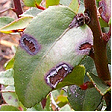 Vaccinium ovatum
Vaccinium ovatum
Vaccinium ovatum is infected by the leaf spot (Rhytisma vaccinii) and (Dothichiza caroliniana).
Vicia species are infected by the leaf spot (Erostrotheca multiformis), which forms greyish spots that enlarge and may defoliate the plant.
Wisteria species are infected by three fungal leaf spots (Phyllostica wisteriae), (Septoria wisteriae) and (Phomatospora wisteriae).
Non-chemical Control
Remove and destroy infected plant material and avoid overhead watering. When planting select infection resistant varieties. Practice crop rotation and add pot ash to the soil to decrease the plants venerability to the disease. Many species of fungus overwinter in fallen leaves, remove and destroy any litter under the plant.
Winter Fusarium Leaf Disease in Turf Grasses can be minimised by aerating the soil, reducing thatch and avoid excessive nitrogen in the soil.
Chemical Control
Protective fungicides such as zineb or copper oxychloride should be sprayed at the first sign of infection and cuttings should be sprayed as they start to grow.
Note
Always read the label for registration details and direction of use prior to application of any chemicals.
DISEASE
NAME
Fungi (General)
Various Fungal species
Description
A fungus is a plant that lacks chlorophyll and conductive tissue. Generally they are made up of branched threads called 'hyphae' and collectively form a vegetative body called 'mycelium'. The fungus is small but the fruiting bodies can become very large up to 600mm across such as bracket fungi or mushrooms. Common fungi are mould and mildews. problem that attacks the roots causing them to rot.
Fungus can reproduce many ways but primarily it is asexually, simular to cuttings of a plant and often occurs with minute portions of the mycelium (spores) separating. The spores can be arranged in a structure such as a sporangia or pycnidia or develop without an enclosed structure called a "conidia". Either way the fungus propagates very rapidly. Sexually reproduction occurs when two nuclei unite and form sexual fruiting bodies (zygospore).
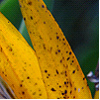 Strelitzia reginae flower
Strelitzia reginae flower
Symptoms
Fungus attacks all the above or below ground level parts of the plant living within the tissue of the plant and are very small and not normally detected until the fruiting body appears. However parasitic types such as powdery mildew or rust are visible on the outer surface of the plant.
Fungi hyphae may be divided by cross walls and known as "septate" while others with no cross walls are known as "nonseptate". These are the fungi responsible for cell leakage as in rot.
Back Mold (Chalariopsis thielavioides) affects understocks of grafted Rosa species by inhibiting the development of callus. It is whitish-grey maturing to black and can be found in the pith of the rose stem.
Black Root Rot (Chalara elegans).This recently introduced fungal disease in Australia (1993) affect plants by blackening the root systems and turning leaves yellow or purple. It is difficult to identify specifically as other pathogenic root diseases and nutritional deficiencies have simular characteristics.
The asexual spores are dispersed by wind or water. It is also transmitted on insects and in contaminated growing media or plants preferring humid moist conditions.
This fungus affects a wide range of ornamental plants including; annuals, perennials and shrubs. Examples are Begonia, Boronia, Camellia, Cyclamen, Fuchsia, Gerbera, Grevillea, Impatiens, Pansy, Petunia, Rosa species and Snapdragon.
Black Stem Rot (Pythium splendens) normally is a rot that occurs in cuttings turning the stem progressively black and shrunken. The leaves fall and the plant becomes stunted, eventually dieing.
Bleeding Necrosis (Botyosphaeria ribis) attacks and kills the inner wood causing the bark to split open and bleed sap giving it an oily appearance.
Blight (Endothia parasitica) is a serious pest of Castanea species, entering the twigs and small branches, and then progressively travelling throughout the tree killing it. It may form cankers on the base of the trunk or in the dead branches above with the amber coloured fruiting bodies pushing there way through the bark.
Copper Web ((Rhizoctonia crocorum). This fungal disease appears in defined patches causing the corms in the centre to become a black powdery mass. Corms on the outer ring of the patch that are partially infected forming a felty mass of violet threads on the corm scales. These threads extend into the soil and large sclerotia forms in the soil and on the corms. Healthy corms become infected from contaminated soil that contains mycelium and sclerotia.
Dry Rot (Phyllosticta concave) forms small circular spots that increase to a diameter of 30mm, and then becomes sunken as the cells collapse. The infected area develops minute black fruiting bodies.
Dutch Elm Disease (Ceratocystis ulmi) is a serious fungal problem of Ulmus species that initially causes yellowing then wilting of the leaves that turn brown and die. This may be seen on certain branches of the tree and on inspection under the bark the sapwood reveals brown streaks. A cross section of the affected branch displays round spots that are dark brown. This infection normally spreads quickly throughout, killing the tree in one to two seasons.
Dieback in Camellia (Glomerella cingulate) is a pathogenic fungus that infecting existing wounds such as leaf scars or mechanical damage, forming a sunken area (canker) that spreads around the stem causing die back. The affected plant has new shoots that are brown-black and the tips curl, forming a 'Shepard's Crook' appearance. The leaves also die but are persistent on the plant and the spores are found in soil or on other infected plants.
Curvularia Leaf Spot (Curvularia species) in Turf Grass. This is normally a secondary weak fungal infection that forms spots on the leaves that lengthens turning the leaves greyish. The leaf shrivels then dies and infected areas appear as weak patches in the turf. Preventive measures include minimising leaf wetness and excessive use of nitrogen fertiliser.
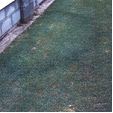 Fairy Rings Blue Couch
Fairy Rings Blue Couch 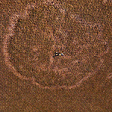
Fairy Rings are a fungal problem in Turf Grass and is caused by several species including (Lycoperdon species), (Marasmius species) and (Tricholoma species). Rings appear in the turf as fruiting bodies or dead grass and as lush green foliage. The mycelia expand radially in the turf feeding on soil nutrients and organic matter with water present.
Under severs conditions the mycelia consume all available nutrients resulting in the death of the turf. Lush turf can result from a less developed infection, where the decomposing hyphal releases nitrogen. This available nitrogen may be beneficial to the turf but some forms of nitrogen are detrimental.
Leaf Blister (Taphrina coerulescens) appears as yellowish circular raised areas on the upper side and depressions on the underside of leaves, up to 15mm across. As the fungus spreads the leaf dies but remains attached to the tree and this infection is commonly found on Quercus species..
Leaf Blotch (Guignardia aesculi) forms small or large water soaked spots that are reddish with a bright yellow margin and form black fruiting bodies in the centre. The affected leaf and petiole have a scorched appearance before falling, found on Aesculus species
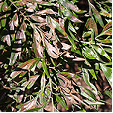 Grevillea robusta
Grevillea robusta 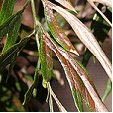 Leaf Scorch
Leaf Scorch
Leaf Scorch (Verrucispora proteacearum) is a fungal disease that infects leaves causing large parts of the leaf to turn grey-brown, giving the appearance that it has been singed by fire. Black fruiting bodies appear on the affected areas and the leaf soon withers then dies. New, mature leaves are affected during very wet periods towards the end of the branches and Grevillea and Hakea species are susceptible.
Melting Out (Helminthosporium vegans) forms bluish black spots with straw coloured centres on the leaves and may be found on the sheath, encircling it causing Foot Rot. It infects grasses particularly Poa pratensis. There is another fungus that is simular Helminthosporium Blight (Helminthosporium dictyoides) that infects Poa, Festuca and Agrostis species.
Pad decay (Aspergilus alliaceus) infects Cereus and Opuntia species and occurs at during periods of high temperature. The yellow spores at the epidermal layer through wounds and germinate on mass causing the area to become soft and spongy. An anthracnose called Shot Hole is a similar forming brownish spots the turn grey, and then black destroying pads. Control methods include physically removing damaged pads and allowing the Sun to heal wounds.
Potato Gangrene (Phoma foveate) is a soil borne fungus that infects the roots during harvest primarly through wounds and develops during storage. The potatoes rot from the inside forming rounded depressions on the surface and have a strong odour of rotten fish.
Root Rot Fungi (Phymatotrichum omnivorum) and (Pellicularia filamentosa) cause the roots to rot and the plant suddenly wilts then dies.
Root Rot (Pythium debaryanum) forms water soaked dark brown streaks that affect all parts of the plant causing wilting then dieing. It infects Ranunculus species, it also infects cactus species by forming brown spotting and wilting that appears at the base of the plant then extends towards the top. It quickly spreads from plant to plant in collections and is controlled by avoiding over watering, excessive humidity and are using a sterilised soil when potting up.
This fungus also is responsible for damping off of seedlings in a glasshouse environment.
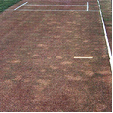 Spring Dead Spot
Spring Dead Spot 
Spring Dead Spot (Leptosphaeri species) is a fungal disease that infects Couch Grass. It first appears during autumn as pale bleaches areas up to 500mm (20in) wide and persists throughout winter. In spring the affected areas do not recover or recover slowly and on inspection the roots or rhizomes are rotted. Runners from the surrounding healthy turf will help with recovery and all signs of the problem disappear by mid summer.
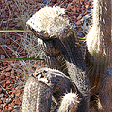 Cactus species
Cactus species 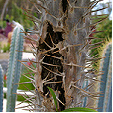 Pachypodium species
Pachypodium species
Stem Rot (Helminthosporium cactivorum) forms well defined yellow lesions that mature into soft dark brown rot. It commonly infects Cactus species entering through the stomates or wounds. Heavily infected plants collapse and die.
Stem Rot or Basal Rot (Pellicularia rolfsii) is a soil borne fungus that infects the stem root junction and extends into the leaves. In orchids the leaves become discoloured, dry and detach from the base which is covered in a fungal growth that produces sclerotia. The sclerotia is whitish to yellow then becoming dark brown and can be viable for up to four years.
White Mold (Ramularia desta f. odorati) occurs on both sides of the leaf and looks simular to powdery mildew but forms faint dull, reddish brown elongated spots on the leaf that may be depressed or along the margin where they have a watery appearance. Tufts of hyphae develop in the stomates.
Wilt (Ceratocystis fagacearum) causes leaves to curl then turn brown and the sap wood may also turn brown or black. Heavy infection may kill a tree within two seasons and is found on Quercus species and other ornamental trees.
Witches Broom may be a fungal problem that causes a proliferation of small axillary shoots to appear at the end of the branches. Little is known about this problem, though it affects a wide range of plants including Eucalyptus, Leptospermum and Pinus species.
Source and Dispersal
Fungus is found in the soil or on other infected plants and after releasing the spores, they are dispersed by wind or are transmitted in infected stock, insects and with splashing water.
Wilt is transmitted by infected root stocks, several species of insect and contaminated tools.
Dutch Elm Disease is transmitted by bark beetles such as (Scolytus multistriatus) and (Hylurgopinus rufipes). These beetles deposit eggs in the sapwood where the lava tunnel and pupate. The emerging beetles tunnel the bark and carry the fungus to fresh feeding sites on the tree. Infected beetles may also be transported to fresh sites in waist material.
Favoured Conditions
Prefers cool moist conditions with temperatures from 10º to 25ºC and is more common from autumn to spring when it is wet.
Affected Plants
A wide range of plants and all parts can be infected by various fungal diseases. Bleeding Necrosis is found in Liquidambar species and Stem Rot or Dry Rot infects Cactus species such as Opuntia and Pelargonium.
Abies species are infected by several fungi that cause Leaf Cast which turn the needles yellow to brown then fall prematurely.
Abutilon species are infected by the Stem Rot (Macrophomina phaseolin) affecting the lower stems and is not commonly seen.
Achillea, Cuphea, Leucanthemum, Euphorbia species are infected by the Stem Rot (Pellicularia filamentosa) which enters through the roots and rots the base of the stem.
Alternanthera species are infected by the Leaf Blight (Phyllosticta amaranthi) which forms small brown spots on the leaves causing them to curl and die.
Aloe, Astrophytum, Copiapoa, Echinocactus, Espostoa, Ferocactus, Gymnocalycium, Kalanchoe and Schlumbergerera species are infected by Bipolaris Stem Rot (Bipolaris cactivora). This infection affects many cacti species causing rot in the stems with a blackish appearance.
Amelanchler is affected by the Witches Broom (Apiosporina collinsii).
Antirrhinum species are infected by the Blight (Phyllosticta antirrhini) that forms light brown spots on the upper-side of the leaf and on the stem. As the spots enlarge they turn greyish with black fruiting bodies in the centre, then become brown and killing the affected areas.
Begonia species are infected by the Stem Rot (Pythium ultimum) turning stems black then becoming soft and causing the plant to collapse. This is the same fungus that causes Damping-off.
Betula species are affected by the Leaf Blister (Taphrina bacteriosperma) which curls the leaves and forms reddish blisters.
Chamaedorea and other cain-like species are infected with Gliocladium Stem Rot (Gliocladium vermoseni) which forms a dark basil stem rot generally on damaged plants and produces orange-pink spores. The mature leaves are first affected and eventually the stems or cains rot and die.
Crocus and Gladiolus species are infected by the Dry Rot (Stromatinia gladioli), which causes lesions on the corms and rots the leaf sheath.
Crocus, Iris, Tulipa, and Narcissus species are infected Copper Web ((Rhizoctonia crocorum).
Dianthus species are infected by Phialophora Wilt (Phialophora cinerescens) that causes the leaves to fade and plants to wilt. There is obvious vascular discoloration which is very dark. It is not found in Australia.
Erythrina x sykesii may be infected by the Root Rot Fungi (Phymatotrichum omnivorum).
Fern species are infected by Tip Blight (Phyllosticta pteridis). This blight produces ash-grey spots with purple brown margins and the fruiting bodies appear as black pimple like spots. It is transmitted by air or moisture and in infected fronds become brown and die. Control methods include sprang fungicide on leaves or reducing humidity and avoid wetting the fronds.
Forsythia species are infected by Stem Gall (Phomopsis species). It forms rounded growths along the stems causing them to die and look unsightly.
Gladiolus species are infected by Penicillium Rot of Corms (Penicillium gladioli). This disease forms deeply sunken reddish brown areas that become corky and produce a greenish fungal growth.
Hedera species are susceptible to several Fungal Leaf Spots including (Glomerella cingulate), (Phyllosticta concentrica) and (Ramularia hedericola). All of which cause yellowish spots that develop into dry brown blotches that kill the leaf.
Larix species are susceptible to Leaf Cast (Hypodermella laricis). This fungus attacks the needles and spur shoots turning them yellow at first then brown after which small black fruiting bodies appear on the leaves during winter.
There are several other fungi including (Cladosporium species) and (Lophodermium laricis) cause leaf blight or leaf casts.
Orchids such as Cattleya, Cymbidium, Cypripedium, Dendrobium, Epidendrum, Oncidium, Paphiopedilum, Phalaenopsis and Zygopetalum species are infected by Phomopsis Rot (Phomopsis species). This fungal problem forms a firm brown rot that appears on the leaves, pseudobulbs and rhizomes. The affected areas have yellow margins and the centre is covered in tiny black specks (fruiting bodies). Cattleya species are particularly susceptible. These plants are also infected by Psudobulb Rot (Mycolleptodiscus coloratus implicated). Dark spots appear on the pseudobulbs eventually causing extensive rot and killing the bulb.
Palms are infected by the fungus Butt Rot (Ganoderma sulcatum). The fungus entered the lower trunk normally as a result of mechanical damage (lawn mower). Symptoms include stunting of new growth and yellowing of the lower leaves. Fruiting bodies become evident at the base of the trunk. There is no effective control method and replanting in infected soil should be avoided.
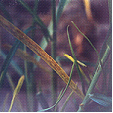 Kikuyu Yellows
Kikuyu Yellows 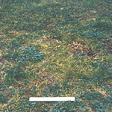
Pennisetum clandestinum (Kikuyu) is susceptible to Kikuyu Yellows (Verrucalvus flavofaciens), thisis a water mould that infects the roots and causes them to rot. The infection extends up the stem and onto the leaves with yellow discolouration and can be limited to a small or large area up to 1m (3ft) wide.
It is found in warm temperate to sub tropical regions and dispersed in infected soil or plant material. There is no chemical control, nitrogen fertiliser masks the symptoms and complete fertiliser encourages stronger roots to fight the disease.
Pittosporum, Antirrhinum, Aquilegia, Echinops and Orchid species are infected by the Stem Rot or Basal Rot (Pellicularia rolfsii) commonly in the northern hemisphere and preferring humid glasshouse conditions.
Solidago species are infected by the fungal Scab (Elsinoe solidaginis) which covers the leaves and stunts the growth of the plant. Young plants may be killed.
Trillium species are infected by the stem rot (Pellicularia rolfsii) and ( Ciborinia trillii). This normally occurs in wet soils and is detrimental to the plants life.
Tsuga species are infected by Sapwood Rot or Butt Rot (Ganoderma lucidum) and (Coniophora puteana), which attacks the sapwood close to the bark, towards the base of the tree. Commonly killing the host.
Tulipa species are affected Blue Mold (Penicillium species) and the fungus (Rhizopus stolonifer) causing rot in the bulbs.
Vinca species are infected by the soil born Root Rot (Pellicularia filamentosa) which rots the stems and roots.
Viola species may be infected with the Scab (Sphaceloma violae) which attacks all parts of the plant including the seed capsule forming yellowish spots that turn brown and in leaves fall out. Stems and petioles can be girdled killing the upper part.
Viola species are also infected with the Stem Rot (Myrothecium roridum) which attacks the stems at ground level causing them to become dry and brittle. The leaves show symptoms by turning purplish-black and this fungus also infects Alcea and Antirrhinum species.
Non-chemical Control
Generally remove and destroy any infected plants or plant parts, when replanting, avoid using susceptible species for 3 years. When growing crops space the plants to reduce the humidity and airflow and cultivate the soil to increase the drainage. Remove weed growth from around the susceptible plants.
Avoid over watering the surrounding soil which encourages fungal development. In the case of trees remove any infected branches and heavily infected trees should be cut down and removed. This infected material should be disposed or burnt. Damaged trees should have the wounds dressed and sealed as a preventative measure particularly for Dieback in Camellia.
Deter Potato Gangrene by planting clean stock and be careful not to damage the crop when weeding. When harvesting the tubers choose a dryer period and be careful not to damage them.

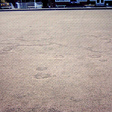 Fairy Rings
Fairy Rings
Fairy Rings in Turf are difficult to control and may appear or disappear sporadically. Cultural practice such as minimal thatch build-up, regular aeration and a reduction of organic matter spread on the turf will reduce infection.
Chemical Control
No suitable fungicides available, though drenching or spraying the soil with the fungicide dichloran helps control soil born fungi.
Note
Always read the label for registration details and direction of use prior to application of any chemicals.
Average Lowest Temperature : -1º C 30º F
USDA : 9, 10, 11
This USDA (United States Department of Agriculture) hardiness zone chart can be used to indicate a plant’s ability to withstand average minimum temperatures. However, other factors such as soil type, pH, and moisture, drainage, humidity and exposure to sun and wind will also have a direct effect on your plant’s survival. Use this chart only as a guide, always keep the other factors in mind when deciding where, when and what to plant.
A plant's individual USDA zone can be found in the Plant Overview.
Region of origin
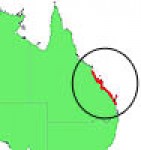
Australia (Eastern Queensland)
Climate Description
Warm to Sub-tropical
This overlaping zone has ample rain with high summer temeperatures and high humidity. Winters are mild. Pockets of sub-tropical climates exist within coastal warm temperate zones.
Frosts and droughts rarely occur along the coast.
Plant growth
Tropical and warm temperate native and exotic plants grow well.
| Dictionary | Growth Habit |
| Leaf Type | Botanic Flower Description |
| Leaf Shape | Flower Inflorescence |
| Leaf Arrangement | Fruit Type |
| Leaf Margin | Bark Type |
| Leaf Apex And Bases | Flower Description |